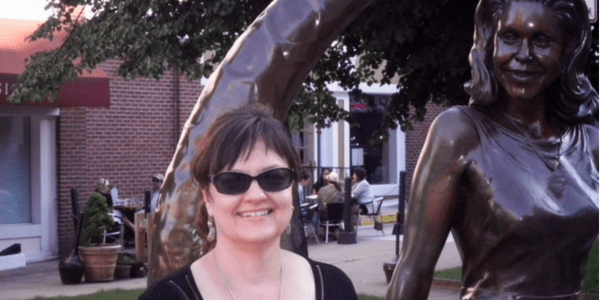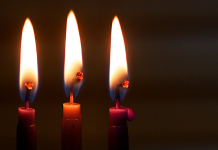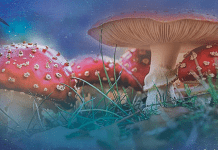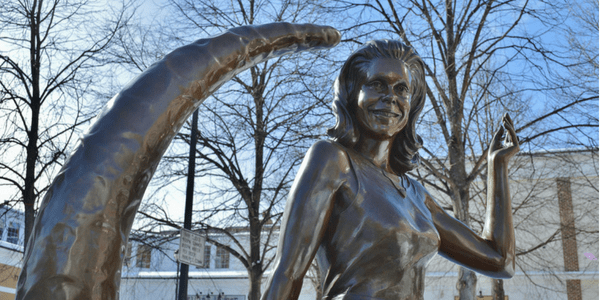 The bumper stickers at the Trolly Depot in Salem, Massachusetts sum up one of my first experiences in Salem, in 2009. Examples such as “Witch parking only — all others will be toad,” “My other car is a broom,” and “Dirt-loving treehugger” were everywhere. Eventually, I selected “Protected by witchcraft” for our bumper. It just seemed right. I am a proud crone, comfortable in my own skin, and have been a practicing witch of more than 40 years.
The bumper stickers at the Trolly Depot in Salem, Massachusetts sum up one of my first experiences in Salem, in 2009. Examples such as “Witch parking only — all others will be toad,” “My other car is a broom,” and “Dirt-loving treehugger” were everywhere. Eventually, I selected “Protected by witchcraft” for our bumper. It just seemed right. I am a proud crone, comfortable in my own skin, and have been a practicing witch of more than 40 years.
Related: Monica Bodirsky’s Lucky Lenormand: An artist’s deck, by Jenna Danchuk
Kitsch witch versus history
I walked from shop to shop on Essex, marvelling at the variety of kitsch witch and authentic Wiccan or witch practitioners businesses, easy to distinguish from one another. I was in my element. Small cauldrons were for sale at the Salem Witch Museum.1 Pentagrams were on everything, and were available everywhere, as well as candles, tarot cards, crystals, jewellery, hard-to-find brooms, cloaks: I was overwhelmed. The Hallowe’en broom-riding hag icon is so prevalent that the Salem police have a witch logo on their uniforms and patrol cars, and it designed by an officer.
But why is all of this marketing happening in a space where 25 people were convicted of witchcraft? In 1692, 14 women and six men were executed, one person died in prison, three were pardoned, and one escaped. This is a horrific blot on history in the United States, and something that Salem has managed to downplay throughout much of its prim New England history. Instead, Salem is often touted as the birthplace of the National Guard, the most vital and earliest seaport in the US, and home of gorgeous federalist architecture. So, why the witch kitsch and stranger yet, why would actual practitioners want to stay in a place with such a horrible witch history?

Living as a witch amongst kitsch
I suppose after many years of reflecting, I can see that most of the United States, and perhaps the world, expects to find witches in Salem, so it only seemed natural for actual witches to move there and practice there. Laurie Cabot is the most famous of these, and she is Salem’s official witch. Cabot, along with many others, teach actual witchcraft as a way to eliminate the stereotypes. Then why the kitsch? Again, people expect witches, but not all want the real thing – just a t-shirt or a doll.
While many people I speak with find the tourist witch schlock cheapens the actual practice, I felt very welcome and not at all insulted. I think being somewhat invisible in Toronto and having people regularly greet me with “Shalom” when they see my pentagram ring is actually more frustrating than people trying to make a living with anything witchy. To me, it is apparent that I am not a bent over hag with a green face — an image so ridiculous that I find it hard to get angry. There are so many young practitioners who are loud and proud, and who are the antithesis of this image that it seems relatively harmless. Of course, not everyone would agree.
Having worked as a history program coordinator at the Native Canadian Centre of Toronto for several years (2002 to 2007) I was frequently called to the retail shop to assist patrons inquisitive about First Nations history. I would invite them to the library upstairs and welcome them; however, they more often than not found the retail experience a safe place to explore — without feeling awkward about their lack of knowledge. I could have told the shoppers about the commodification of culture and it’s deleterious effects; however, I took the opportunity to educate people about cultural resources that offered an alternative to the perceived purchased culture.
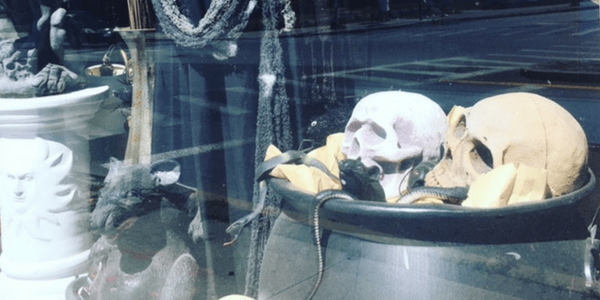
Shopping while witchy
Another practitioner of the craft is Lori Bruno, Hereditary High Priestess and Elder of the Sicilian Strega line of the Craft of the Wise, founder and Head Mother of Our Lord and Lady of the Trinacrian Rose Church, Inc. Her shop, Magika, offers people a place to speak with a practitioner and drop in for a tarot reading. She has held many public ceremonies and generously shares the history of witchcraft practices. I met her many years ago and when I was lucky enough to catch her for five minutes to tell her I wanted to paint her portrait. She smiled knowingly and said, “You’re just like me. You’re one of us.”
Years later I had the pleasure of being in one of Laurie Cabot and having a beautiful and deep conversation with her after the class. There are so many active, contemporary and young witches as well offering their energy and wisdom. It is often through tourism that practitioners are making a living and are able to share their knowledge with a younger generation who desperately need elder witch mentors so our history is not continually erased by “bigger, better, newer,” but built and improved upon with each subsequent generation.
Teri Kallgren, owner of Artemisia Botanicals, is a practicing green witch who runs the Green Witch School of Herbalism from her shop. Kallgren also founded the Witches Education League and ensures that green-faced children are not pretending to be witches at Hallowe’en in public schools without understanding that this is offensive to some. She finds this particular stereotype harmful when children have parents who identify as witches and other children are cruel and say that only green-faced ugly hags are witches. This did make me see the potential harm from the kitsch I witnessed, but it also made me grateful for Terri’s presence.
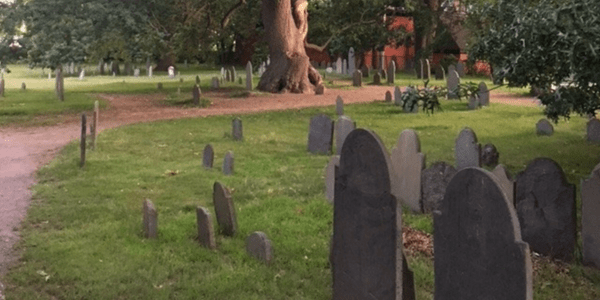
Tensions between historical witches, modern witches, and pop culture
There is no doubt that retail should never replace education, and that it certainly poses challenges,; however, I think it is naïve to feel that we can change the massive machinations of consumerism in North America by being disgruntled. So, perhaps as practicing witches, we may take some of the stereotypes and subvert them or use them as an opportunity to offer education.
In 2005, a bronze statue of Elizabeth Montgomery’s Bewitched character was erected at the corner of Jefferson and Essex in the heart of the tourist district. A relative of one of the victims of the witch trials of 1692 was furious, and this created controversy. Bill Burns, a longtime Salem resident who is a descendent of Rebecca Nurse, felt that the statue was wildly inappropriate and that we should not make fun of witches. Along with Burns, several witch practitioners also protested for a variety of reasons, mostly due to Montgomery’s blonde, cute nose wrinkling portrayal of a witch. I understand the frustration, yet she is a pop culture icon, and it is a tourist town. There is a balance in a very beautiful monument in front of the old Burying Point Cemetery in honour of those executed, which is well-considered, tasteful and allows visitors to leave flowers, tokens, and to contemplate history without any tourist schlock attached.2
Interestingly, several current practitioners who offer walking tours use the Bewitched statue as a stopping point to explain the differences between TV’s rather silly portrayal of witches, and true witchcraft and Pagan spirituality. This is subverting from within, and like judo, using the energy of what is coming towards you to throw it over your head, can sometimes be a better tactic than trying to meet force with force.
Related: Hallowe’en: From community celebration to sabbath of evil, by Donyae Coles
Disentangling witch hunts from modern witchcraft
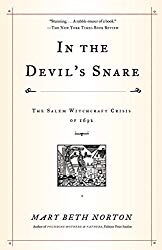 I would also like to add that there is a real danger in associating the witch trials with the practice of witchcraft when several contemporary Salem historical books, such as In the Devil’s Snare: The Salem Witchcraft Crisis of 1692 by Mary Beth Norton, which supports the idea that it was actually a complex and perfect storm of socio-economic and political hysteria and fear that spurned the trials, and not witchcraft. In fact, witchcraft was used by Puritans, and accepted as a natural solution to many health issues when herbalism was the only medicine available. Witch bottles were made with pins, urine, and other items thought to protect from and repel witches, as was placing footwear within the walls of homes to protect from invading negative spirits. To add to this, corpse medicine was practiced at that time by so-called credible male European physicians who believed that body parts taken from executed criminals and ground to powder could be used to cure ailments such as epilepsy, kidney problems, and lung conditions.
I would also like to add that there is a real danger in associating the witch trials with the practice of witchcraft when several contemporary Salem historical books, such as In the Devil’s Snare: The Salem Witchcraft Crisis of 1692 by Mary Beth Norton, which supports the idea that it was actually a complex and perfect storm of socio-economic and political hysteria and fear that spurned the trials, and not witchcraft. In fact, witchcraft was used by Puritans, and accepted as a natural solution to many health issues when herbalism was the only medicine available. Witch bottles were made with pins, urine, and other items thought to protect from and repel witches, as was placing footwear within the walls of homes to protect from invading negative spirits. To add to this, corpse medicine was practiced at that time by so-called credible male European physicians who believed that body parts taken from executed criminals and ground to powder could be used to cure ailments such as epilepsy, kidney problems, and lung conditions.
Understandably, the number of tacky museums professing witch history captivates some, but they are very focused on the singular history of the trials. This is changing slowly, and current Wiccan and witch practices are now being highlighted as well, so people realize it is a current and evolving practice.
Related: The Witch, reviewed by Mark Jones
Related: Four Thieves: From medicine to magick, Anie Savino
Related: Not my Burning Times: Witch trials, oppression, and magical identity making, by Donyae Coles
Final thoughts
In kitsch versus witch, who wins? I think they can co-exist.
Consumerism is not going to disappear any time soon, so perhaps the answer is to be discerning, provide education, and look at Salem as a locus of witch activity — both real and imagined. In the end, practitioners can decide individually what is or isn’t offensive, and take appropriate action.
In the meantime, I am going to the Witch’s Brew Café for lunch, then shopping at Salemdipity for a few candles, and later, it’s off to hold a small vigil for those who suffered persecution, and to commune with the lively dead.
Related: The wandering witch: An interview with Natalie Zaman, by Syndee Barwick
Related: Magical Destinations of the Northeast, reviewed by Susan Starr
Map
Image credits: Massachusetts Office of Travel and Tourism, Tony Webster, and Monica Bodirsky
- Salem Witch Museum, salemwitchmuseum.com. [↩]
- Anthony Brooks, “Salem Residents Oppose Planned ‘Bewitched’ Statue,” All Things Considered, NPR, 5 May 2005. [↩]


